Thursday, November 11, 2010
The use of artificial lights is very important in extending the egg production of ducks. An increasing day length (December 21 to June 21) stimulates birds to lay more eggs and shorter days (June 21 to December 21) stimulate them to lay fewer eggs and eventually stop egg production. Therefore, the control of day length is very important in starting, maintaining and stopping egg production in ducks.
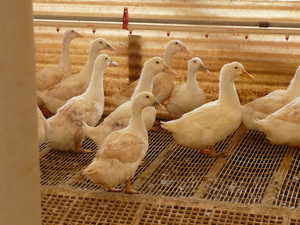
To start egg production
When we stimulate our duck breeders to start egg production in December, we add ¾ of an hour in the morning and ¾ hour in the evening to the natural day length. Then every 3-4 days we add another half hour alternating between the morning and evening until we get to a total of 17 hours of light and 7 hours of dark.
To maintain egg production
It is important that you increase your day length to equal the longest day of the year in your latitude. Why? So that your ducks never notice the days getting shorter starting June 21. Let us assume your longest natural day length is 17 hours but you only added enough artificial light in the spring to go up to 16 hours. Well, your birds will be subjected to increasingly shorter days from June 21 until some time in July or August when the natural day length is down to 16 hours. And they will lay fewer eggs because of this shortening of their day. From that point on they will have 16 hours of light, but some of the damage will have already occurred.
When we stimulate our duck breeders to start egg production in December, we add ¾ of an hour in the morning and ¾ hour in the evening to the natural day length. Then every 3-4 days we add another half hour alternating between the morning and evening until we get to a total of 17 hours of light and 7 hours of dark.
To maintain egg production
It is important that you increase your day length to equal the longest day of the year in your latitude. Why? So that your ducks never notice the days getting shorter starting June 21. Let us assume your longest natural day length is 17 hours but you only added enough artificial light in the spring to go up to 16 hours. Well, your birds will be subjected to increasingly shorter days from June 21 until some time in July or August when the natural day length is down to 16 hours. And they will lay fewer eggs because of this shortening of their day. From that point on they will have 16 hours of light, but some of the damage will have already occurred.
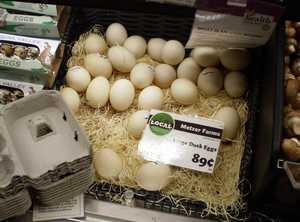
To stop egg production
If you want your birds to go into a molt, turn off the artificial lights. This will help shock their system into a molt and rest period.
Intensity of Light
Birds do not need an intense light to stimulate them. It can be as little as .5 footcandle but it is probably better to get a level of 3-5 footcandles. In general this means sufficient light to read a newspaper. Oftentimes this light level is met about a half hour prior to sunrise and stops a half hour after sunset.
The following charts show the natural day length of three latitudes in the US. You can set your day length according to these charts. If you prefer, you can go the Gaisma website for a chart like this for your city. For exact sunrise and sunset times for every day of the year in your town, you can go to the US Navy Oceanography website. You want to use the civil sunrise and sunset times (the sun is 6 degrees below the horizon) as this is about the point the light is at about 3-5 footcandles.
These charts are marked in military time – 6 is 6am, 12 is noon, 18 is 6pm. Sample cities for each sample latitude are shown below each chart.
If you want your birds to go into a molt, turn off the artificial lights. This will help shock their system into a molt and rest period.
Intensity of Light
Birds do not need an intense light to stimulate them. It can be as little as .5 footcandle but it is probably better to get a level of 3-5 footcandles. In general this means sufficient light to read a newspaper. Oftentimes this light level is met about a half hour prior to sunrise and stops a half hour after sunset.
The following charts show the natural day length of three latitudes in the US. You can set your day length according to these charts. If you prefer, you can go the Gaisma website for a chart like this for your city. For exact sunrise and sunset times for every day of the year in your town, you can go to the US Navy Oceanography website. You want to use the civil sunrise and sunset times (the sun is 6 degrees below the horizon) as this is about the point the light is at about 3-5 footcandles.
These charts are marked in military time – 6 is 6am, 12 is noon, 18 is 6pm. Sample cities for each sample latitude are shown below each chart.
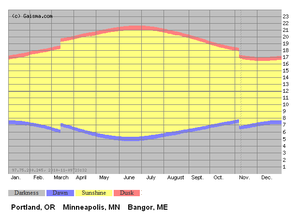
For this northern latitude, the lights should come on about 4:30am and go off at 9:45pm.
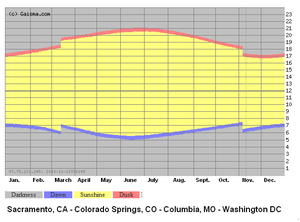
For this central latitude, the lights should come on about 5am and turn off about 9:15pm.
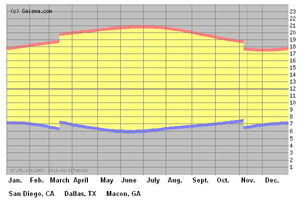
In this southern US latitude, the lights should come on about 5:45am and go off at 9:00pm.
Next week we will discuss timeclocks, types of lights to use, how to make sure your lights are working and how geese do not follow the same rules as ducks in terms of light stimulation and egg production.
Next week we will discuss timeclocks, types of lights to use, how to make sure your lights are working and how geese do not follow the same rules as ducks in terms of light stimulation and egg production.